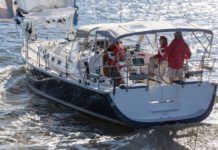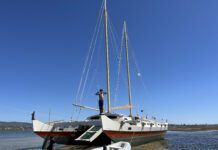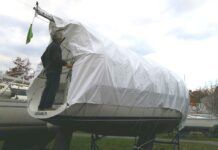Sustaining speed with wider tacking angles will help overcome leeway.
Cruising cats can’t go to windward. That’s the rumor, and there’s a kernel of truth to it. Most lack deep keels or dagger boards and ex-charter cats are tragically under canvassed for lighter wind areas, a nod to near universal lack of multihull experience among charter skippers. Gotta keep them safe. But there are a few tricks that make the worst pig passable and the better cats downright weatherly. Those of you that learned your craft racing Hobies and Prindles know most of this stuff, but for the rest of you cruising cat sailors, there’s some stuff the owner’s manual leaves out.
“Tune” the Mast
Having no backstay means that the forestay cannot be kept tight unless you want to turn your boat into a banana and over stress the cap shrouds. Although the spreaders are swept back, they are designed primarily for side force with just a bit of pull on the forestay. The real forestay tension comes from mainsheet tension.
Why is it so important to keep the forestay stay tight? Leeward sag forces cloth into the luff of the genoa, making it fuller and blunting the entry into the wind. The draft moves aft, the slot is pinched, and aerodynamic drag increases. Even worse, leeway (sideslip) increases, further increasing drag and sliding you away from your destination. Sailing a cruising cat to windward is about fine tuning the lift to drag ratio, not just finding more power.
How do you avoid easing the mainsheet in strong winds? First, ease the traveler instead. To avoid pinching the slot, keep the main outhaul tight to flatten the lower portion of the main. Use a smaller jib or roll up some genoa; overlap closes the slot. Reef if need be; it is better to keep a smaller mainsail tight than to drag a loose mainsail upwind, with the resultant loose forestay and clogged slot. You will see monos with the main twisted off in a blow. Ignore them, they are not cruising cats. It is also physically much easier to play the traveler than the main sheet. Be glad you have a wide one.
Check Sheeting Angles
Very likely you do not have enough keel area to support large headsails. As a result, you don’t want the tight genoa lead angles of a deep keeled monohull. All you’ll do is sail sideways. Too loose, on the other hand, and you can’t point. In general, 7-10 degrees is discussed for monos that want to pinch up to 40 degrees true, but 14-16 degrees makes more sense for cruising cats that will sail at no less than 50 degrees true. Rig up some temporary barber haulers and experiment. Then install a permanent Barber-hauler; see “Try a Barber Hauler for Better Sail Trim,” Practical Sailor, September 2019.
The result will be slightly wider tacking angles, perhaps 105 degrees including leeway, but this will be faster for you. You don’t have the same hull speed limit, so let that work for you. Just don’t get tempted off onto a reach; you need to steer with the jib not far from luffing.
Watch the fore/aft lead position as well. You want the jib to twist off to match the main. Typically it should be right on the spreaders, but that depends on the spreaders. If you have aft swept shrouds, you may need to roll up a little genoa, to 110% max.
Use your Tell-Tales
On the jib there can be tell-tale ribbons all over, but on the main the only ones that count are on the leech. Keep all but the top one streaming aft. Telltales on the body of sail are confused by either mast turbulence (windward side) or pasted down by jib flow (leeward side) and won’t tell you much. But if the leach telltales suck around to leeward you are over sheeted.
Keep Your Bottom Clean
It’s not just about speed, it’s also pointing angle. Anything that robs speed also makes you go sideways, since with less flow over the foil there will be less lift. Flow over the foils themselves will be turbulent. Nothing slows you down like a dirty bottom.
Reef Wisdom
Push hard, but reef when you need to. You will have the greatest lift vs. windage ratio when you are driving hard. That said, it’s smart to reef most cruising cats well before they lift a hull to avoid overloading the keels. If you are feathering in the lulls or allowing sails to twist off, it’s time to reef.

Don’t Pinch
Pinching (pointing to high) doesn’t work for cats. Get them moving, let the helm get a little lighter (the result of good flow over the rudder and keel), and then head up until the feeling begins to falter. How do you know when it’s right? Experiment with tacking angles (GPS not compass, because you want to include leeway in your figuring) and speed until the pair feel optimized. With a genoa and full main trimmed in well, inside tracks and modified keels, and relatively smooth water, our test PDQ can tack through 100 degrees with the boat on autopilot. Hand steering can do a little better, though it’s not actually faster to windward. If we reef or use the self-tacking jib, that might open up to 110-115 degrees, depending on wave conditions. Reefing the main works better than rolling up jib.
Boats with daggerboards or centerboards. The comments about keeping a tight forestay and importance of a clean bottom are universal. But the reduction in leeway will allow you to point up a little higher, as high as monohulls if you want to. But if you point as high as you can, you won’t go any faster than similar monohulls, and quite probably slower. As a general rule, tacking through less than 90 degrees, even though possible, is not the best strategy. A slightly wider angle, such as 100 degrees, will give a big jump in boat speed with very little leeway.

































